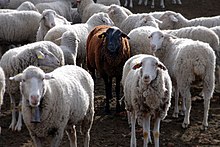Interesting social sciences/Psychology of crowd
Organization of the mass riots as one from methods of political conflict. Can the agitator control the actions of the crowd fully?






Gustav Le Bon became by author of theory about the psychology of the crowd. [1] The crowd is devoid of reason, the crowd looks like a herd of rams. Man in the crowd is a mediocre man, ready to heroic and barbaric behavior. Man in the crowd has feeling of invincible power. Man in the crowd is ready to kill, to participate in riots, to run away or to admire by chieftain. Anonymity of the participants of the crowd allows to feel self irresponsible and unpunished. As if it demolishes consciousness in a person in a crowd and as if it exposes an unconscious foundation, this unconscious foundation is identical at all people. Instincts, main of which – a herd instinct are bared. Man in the crowd are a barbarian and savage, which has enthusiasm and heroism of primitive beings.[2] The aggressive crowd is ready to destroy everything on the way, to beat windows and to kill of people. An example of actions of aggressive crowd are the Jewish riots in Russia at the beginning of 20 century, vandalism of football fans at stadium and electric trains, riots in the markets which "skinheads" arrange. "Skinheads" kill people of southern nations.
The example of the running - away crowd is panic at the front. The example of worship of crowd to own chieftain is a behavior of fans on a rock concert. The example of worship of crowd to own chief is torch processions and meetings in Nuremberg when Adolf Hitler was able to bring extent of worship to own person to ecstasy. Often participants of crowd perish as a result of a crush. The crush on Khodynka Field during crowning of Nicholas II (1389 people have died) or a crush during Stalin's funeral are examples of the crush. That not to risk by own life and health, that not to perish in a crush, it is necessary to avoid to be a participant of crowd.
Conclusion: the agitator can control the crowd partially only.
Why do people participate in the actions of the crowd?
[edit | edit source]According to the theory of behavioral contagion of Gustav Le Bon, the person in crowd turns into a cruel mad beast, at the same time behavioral contagion or epidemic extends as if a virus of violence or fear passes from one man to another. According to Herbert Blumer: the fear extends in herd of animals through low, heavy breathing and so on, that leads to panic escape. Social anxiety and fear manifests itself through turmoil and fuss, through rumors and exaggerations, through a call to act, through increasing of suggestibility and aggressiveness of behavior of people in crowd of people. [3]
Herbert Blumer selects several stages of increase of aggression of crowd:
- Сrowd when people revolve randomly near each other like sheep. In this state, people are preparing to act together.
- Collective excitement which makes the person as irresponsible.
- Social epidemic which extends very quickly. An examples of an infection are tulip mania in Holland in 17 century, a dancing mania in the Middle Ages, military hysteria in 20 century, exchange panic.
Two types of agitators:
[edit | edit source]- Excited and aggressive man who calls for the fight, he uses dramatic and theatrical gestures, for example, he tears shirt on his breasts and he cries loudly. He has success when the audience excited and the audience is knocked out of track already; otherwise his behavior could cause their burst of laughter.
- Calmer person who is able to anger crowd by means of caustic and sharp words.[4]
Demagogy
[edit | edit source]Demagogue is a man who knows how to influence to the crowd.
Methods of influencing on the crowd by demagogue:
- It need pronounce the words with pathos and awe. The mind disappears at people in crowd, therefore it is impossible to influence on them by means of rational proofs. But if words of demagogue are spoken with pathos and awe then the heads bow obediently.
- According to Gustave Le Bon, mass is an obedient herd which cannot live without master and mass is ready to obey to anything who will call himself by her lord. In contrast, according to Sigmund Freud, the сhieftain has to correspond to needs of crowd by own personal qualities. The сhieftain has to be by fanatic captured by deep belief in the idea to awaken this belief in crowd. Chieftain must possess by strong will, unwilling mass borrows this strong will at chieftain. Crowd respects force, even violence from the chieftain, but crowd considers the kindness as a sort of weakness. The crowd is changeable and impulsive. The instincts direct by crowd. The crowd feels all - powerful, the concept of impossible disappears at person in crowd. The crowd reaches the extreme immediately, the stated suspicion turns into unshakable confidence immediately, antipathy grain turns into wild hatred.
- It is necessary to picture the brightest paints and to exaggerate.
Examples of demagogues: Adoif Hitler, Vladimir Lenin, Leon Trotsky, Vladimir Zhirinovsky, Nikita Khrushchev.
Adolf Hitler played the role of religious prophet during speeches, Adolf Hitler used the two following methods:
- Adolf Hitler liked to speak at dusk or at night.
- Adolf Hitler began own speech with quiet words, and Adolf Hitler finished own speech with hysterical cries.
Leon Trotsky liked to use a popular expressions, for this purpose the notebook with the prepared in advance popular expressions lay at him in a pocket during the performance.
Citations and references.
[edit | edit source]- ↑ Gustave Le Bon. The Crowd: A Study of the Popular Mind. 1895. https://www.files.ethz.ch/isn/125518/1414_LeBon.pdf
- ↑ Sigmund Freud. Group Psychology and the Analysis of the Ego. Chapter II. Le Bon’s Description of the Group Mind. https://www.bartleby.com/290/2.html
- ↑ Herbert Blumer. Collective Behavior. Bobbs-Merrill, 1957.
- ↑ Herbert Blumer. Collective Behavior. Bobbs-Merrill, 1957.
